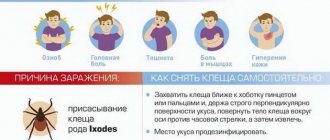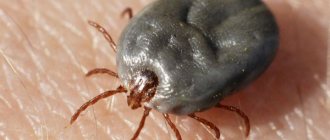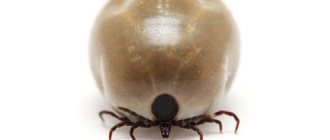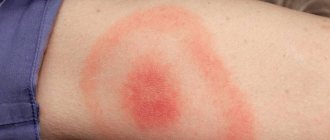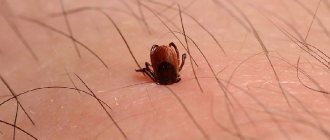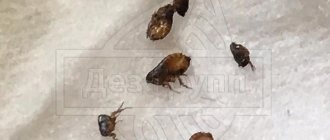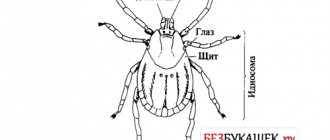In spring and summer, as soon as the sun begins to warm up, everyone rushes to nature - to the forest, to dachas, to parks, etc. At the same time, we often do not fully understand what danger forest ticks pose to humans, and to domestic animals too. In fact, a small and inconspicuous forest tick often becomes a carrier of serious diseases, the number of which reaches 60!
In this article, let's get acquainted with these little vampires, their varieties, find out why they are so dangerous, how to deal with forest ticks and how to act correctly when bitten.
A forest tick bite can cause about 60 diseases
What does a forest tick look like?
Forest tick
is an arachnid insect with an oval-shaped body, on the upper side of which there is a shield. In male ticks, the shield covers the entire upper side of the body, and the body of the insect itself has a hard skeleton. In females and nymphs of ticks, as well as ticks in the larval stage, the shield covers only the front part of the upper side, other parts of the oval body are soft, this allows the ticks to increase in size when stretched during blood sucking. Males of the European forest tick are brown in color and about 2.5 millimeters long. Female ticks are larger than males; the length of a female tick in a hungry state is 4 millimeters; after saturation with blood, the body of a female tick increases in size to 11 millimeters and becomes gray in color. Ticks have 4 pairs of legs, four on the right and left sides of the body. The forest tick differs from the taiga tick in the marginal furrow of the body; the forest tick does not have this body outline in the lower part, but the taiga tick has such an outline along the entire edge of the body.
the image is the property of the Finnish University of Turku
Appearance of the parasite
Dog, taiga and other ixodid ticks look similar to each other in appearance (see pictures below). Sometimes even specialists cannot quickly distinguish them without additional thorough research.
The color and size of these parasites can vary widely: from flesh-colored to dark gray or brown. Folds on the integument can sometimes form bizarre patterns, and the soft chitin of larvae and nymphs is translucent - the color of blood in the tick’s digestive system is visible through it.
Thus, when trying to determine the type of attached parasite, there is no point in relying only on color.
All ixodids also have a similar type of body structure. It consists of the head section (gnatosomes) and the body (idiosomes) - the structural features can be seen in more detail in the photograph below:
The idiosome has the appearance of a highly extensible sac, thanks to which the parasite can absorb blood in volumes significantly exceeding the body size of a hungry individual.
On the ventral side of the idiosoma there are four pairs of walking legs (tick larvae have only 3 pairs of legs, so sometimes people confuse them with insects).
In adult individuals, sexual dimorphism is well expressed: males are very different from females. Firstly, males are much smaller than females; the dorsal part of their body is covered with a dense shiny shield that reaches the top of the abdomen. Because of this, the body of males does not stretch as much as that of females, in which the scute reaches only half of the back.
Females are usually larger than males and feed on the host longer (sometimes adult males do not drink blood at all, and quickly die after mating). The success of the formation of mature eggs and the continuation of the parasite species depend on blood saturation. If for some reason the female did not find a host or fell away without being fully nourished, then the reproductive products will not form inside her, and she will not be able to lay eggs.
Hyalomma anatolicum (left - female, right - male)
On the head section of the tick's body there are simple eyes that perceive changes in light intensity. The main sensitive function is performed by the chemical sense organs located on the paws: it is by smell that the tick finds its victim. Bloodsuckers also react intensely to heat (infrared radiation), which is scattered from warm-blooded animals.
Of particular interest is the structure of the tick's oral apparatus, which can only be examined in detail under a microscope. The parasite's oral apparatus consists of:
- hypostome (proboscis with a rim of hooks);
- pairs of chelicerae;
- pairs of pedipalps.
The pedipalps contain the sensory organs discussed earlier. Chelicerae look like sharp knives that cut the integument of the victim. The proboscis looks like an elongated harpoon cylinder: when bitten, the parasite completely immerses it in the wound, feeding on blood, lymph and inflammation products.
On a note
The tick is very firmly fixed in the wound thanks to a rim of hooks located in longitudinal rows along the entire proboscis. They differ in size and angle of inclination. After inserting the oral apparatus, the hooks become tightly fixed in the skin and tissues, especially if you try to forcefully pull out the parasite. Often such a procedure ends for the victim with the proboscis remaining in the wound.
Forest tick activity season
The active season of forest ticks begins in early spring; individual insects appear before the snow finally melts. In the North-West region, the first visits to medical institutions after forest tick bites were officially registered in early March. The peak population of forest ticks occurs at the end of May - beginning of June. From July the number of insects decreases, in August - September the number of ticks increases again, as the second wave of parasite invasion begins and their numbers increase everywhere.
Forest tick habitat
Ticks live in vegetation close to the surface of the earth, the main habitat of ticks is the forest floor of compacted leaves, fallen needles, grass and moss; the opinion that ticks live in tree branches is erroneous. In humans, ticks appear first on the legs, after which they crawl up them; for this reason, insects are most often found on the legs, knees and thighs.
How a tick bites
After falling on a person, the tick crawls along it from bottom to top in search of thin areas of skin. Common sites for tick bites in adults are the legs, buttocks and genital areas. Ticks most often bite children on the head; according to statistics, it accounts for 75% of insect bites. It may take several hours from the moment it gets on your clothing until it bites. For this reason, after visiting forested areas or untreated city parks, it is necessary to carefully inspect all clothing, both from the outside, in search of insects crawling on it, and from the inside, to make sure that there are no parasites crawling under the clothes. Over the previous year, 175,000 cases of tick bite victims visiting medical institutions were registered in Russia, of which 47,000 were children (26.8%).
Shouldn't government health services poison ticks for free?
No, they shouldn't. State sanitary services generally do not have such an obligation to poison ticks. Their task is to control and record the sanitary situation in premises and territories. And maintaining a normal situation (including the extermination of ticks) is the task of either the owners of the plots or the authorities managing certain territories (including, for example, arable land, cemeteries, territories owned by state corporations).
Specifically on private territory, the owner of this territory must ensure the absence of ticks. If he cannot treat the area on his own, he needs to order such treatment from a special sanitary service.
Treatment of the park area
Similarly, the local area within the city, near an apartment building, must be treated by a private SES on the order of the management company or the authorities of the district in which this house is located. In fact, such treatment is most often ordered independently by the residents of the house themselves, having cooperated and raised funds collectively. And, by the way, since the common area of the house is usually small, clearing it of ticks is not at all expensive for each specific apartment.
Danger of forest ticks for humans
The forest tick is a keeper and carrier of infections that pose a mortal danger to humans. One insect can contain several types of viruses - tick-borne encephalitis, tick-borne borreliosis, tick-borne rickettsiosis, ehrlichiosis, babesiosis, anaplasmosis. Pathogens enter the human blood through the tick's saliva, which the tick releases to relieve pain when bitten. The incubation period ranges from two to fourteen days; as a rule, this is a fairly acute infection, accompanied by chills, fever, and elevated temperature. The victim's face becomes redder as a result of hyperemia; in some cases, hyperemia spreads to the entire body of the person bitten by a tick. No one is safe from a tick bite. Ticks are not selective; they bite all warm-blooded animals, without distinction based on gender or age restrictions. The number of fatal cases among people infected with tick-borne encephalitis ranges from 2% to 6%; annually in Russia from 25 to 50 cases of tick-borne encephalitis with a fatal outcome are recorded. The risk of contracting tick-borne encephalitis is negligible; only 2–3% of ticks are carriers of the disease. However, the optimal solution in a situation where a tick has bitten is to remove the insect and submit it to the laboratory for analysis, so that a professional infectious disease specialist can check the parasite for infection in its body.
Precautions against ticks
To protect yourself from ticks and avoid their bites, you need to take precautions when visiting natural sites, forests, city parks and other recreational areas. First of all, it is necessary to understand that ticks pose an absolutely real threat to life and health, thereby realizing that precautionary measures in tick habitats are mandatory, not desirable.
I
When visiting areas where ticks are likely to be present, for example, a mixed forest of deciduous trees, you need to dress in such a way that your clothing does not allow ticks to crawl under it - trousers tucked into boots or socks, a long-sleeved shirt tucked into trousers, tightly fitting to the body of the collar of the shirt and sleeve cuffs, a mandatory headdress. Preference should be given to light-colored clothing, on which insects can be easily spotted
II
The optimal solution before going to the forest would be to treat outer clothing with a solution of an acaricidal agent against ticks; if ticks get on treated clothing, after a short time they will lose their tenacity and the ability to crawl on it, fall off and die. The solution requires a cypermethrin-based product, for example, Tsifox anti-tick product
III
When camping in nature with an overnight stay, you must choose places devoid of grass, for example, dry areas in a pine forest or areas with sandy soil. Before and after spending the night outdoors, you need to carefully inspect your clothes, body and hair to make sure there are no insects
IV
After visiting natural places with pets, you need to carefully examine your pets to make sure they are free of ticks.
V
To sit in the forest, you should choose a stump or a stone; you should not sit or lie on the grass
Protection in all directions
Epidemiologists claim that many of those bitten were not injured in the forest, but in local areas and summer cottages. Ticks can come directly into your home on animals - dogs and cats; they can be brought by guests on clothes or with wildflowers and branches.
– Anti-tick sprays or lotions are a good way to protect yourself. The main thing is to read the instructions, advises Ekaterina Morozova. – In addition to age restrictions, it indicates the time during which the product is effective, and the range is large – from 30 minutes to several hours. Even when using these products, check your clothes and skin every hour and a half. First of all, look carefully at the folds of the skin: ticks love warm and moist places.
Remember that it is easier to see the insect on light-colored clothing.
Bitten by a tick what to do
Once a bitten tick is found on the body, it must be carefully removed. Removal of a tick is carried out using tweezers; you need to carefully grab the tick as close as possible to the site of the bite on the skin, strictly perpendicular to the surface of the skin, and without sudden movements, slowly rotate the insect around its axis clockwise and counterclockwise, carefully ensuring that do not tear the insect's head from its body and leave it in the skin. After removing the insect, it is necessary to thoroughly disinfect the bite site with any available means suitable for these purposes - cologne, iodine or undiluted alcohol.
If the tick's head remains in the body
If a tick is decapitated during its removal, this will be visible as a black dot at the site of the bite; swelling, slight swelling, and possible discharge of pus may appear on the damaged area of the skin. The bite site must be treated with chlorhexidine for external use several times a day. In rare cases, if the head of the tick remains in the body, there may be a pronounced inflammatory reaction at the site of the bite, characterized by large swelling, increased temperature and copious discharge of pus. The tick's head remaining in the body does not affect the likelihood of illness, since infection occurs at the time of the bite due to bacteria in the parasite's saliva. If the head of the tick remains in the body, and a skin abscess (a pus-filled lump the size of a large pea) appears at the site of the bite, the boil can be pierced with a disinfected needle, the head of the tick should come out of the body along with the pus. The site of the abscess must be disinfected with antibacterial cream or special ointment, sold at any pharmacy.
Symptoms of tick-borne encephalitis
Often this disease is disguised as a cold or ordinary malaise. Also, often symptoms of encephalitis begin to appear only 30 days after infection. These include the following conditions:
- weakness in the neck, as well as in the arms and legs;
- increase in body temperature. Often the fever cannot be brought down within several days.
- appearance and intensification of headaches, nausea, vomiting, dizziness;
- development of photophobia, the appearance of hallucinations, deafening of consciousness;
- numbness of the limbs, weakness and pain in the muscles, the occurrence of convulsions, epileptic seizures and even paralysis.
